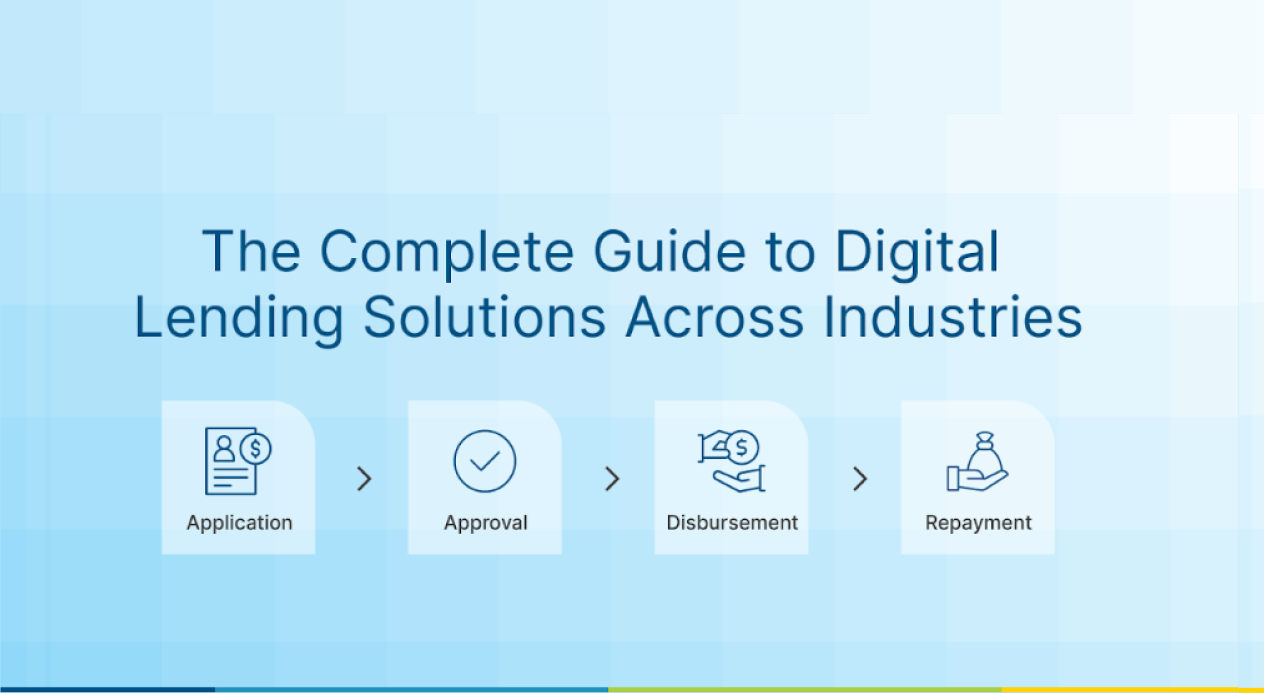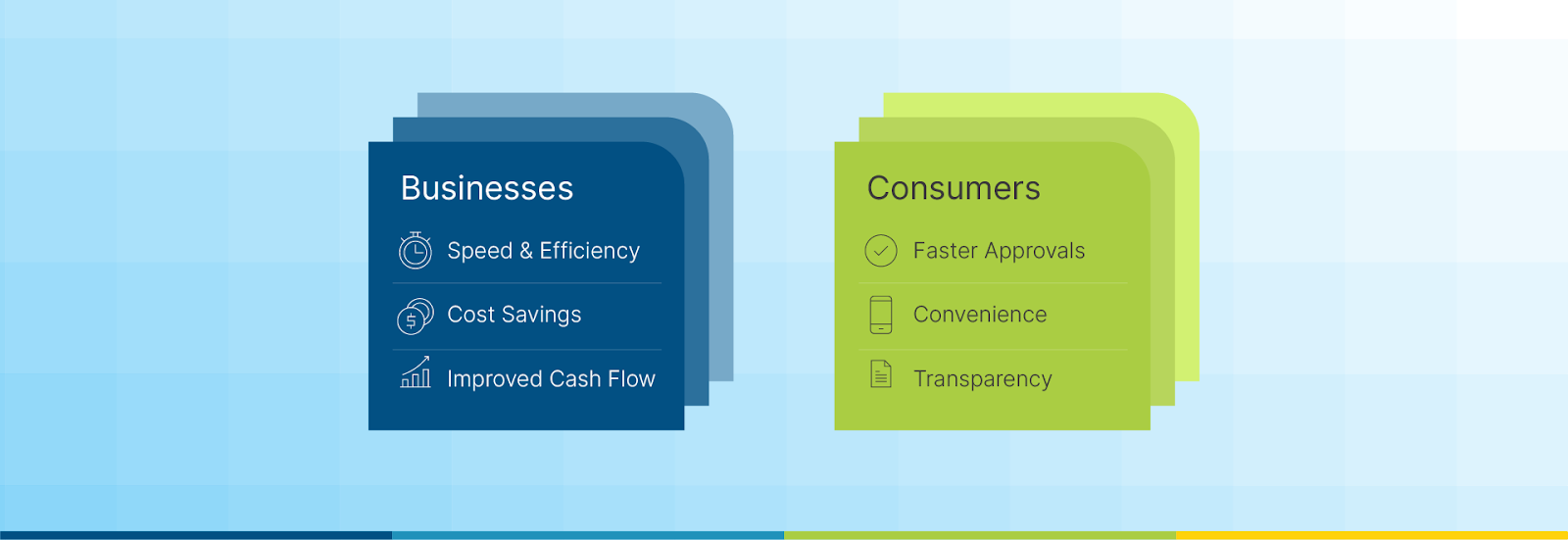The Complete Guide to Digital Lending Solutions Across Industries

Digital lending refers to the use of technology to manage the entire loan process, from application to disbursement and servicing. By leveraging automation, artificial intelligence (AI), and data analytics, digital lending solutions have streamlined traditional lending processes, making them faster, more efficient, and accessible.
These solutions are increasingly used across different industries and for business, commercial, consumer, asset financing, and even for government and public funding to provide quicker access to funds and improve overall customer experience.
This guide will explore how digital lending solutions are applied across various industries, the benefits they bring to both businesses and consumers, and how businesses can implement these solutions to improve efficiency and cash flow management.
What Are Digital Lending Solutions?
Digital lending solutions are software and platforms that enable businesses to offer loans through fully automated processes. These platforms replace manual procedures, such as paperwork and in-person meetings, with digital workflows that accelerate loan approval and disbursement.
Key components of digital lending solutions include:
- Loan Origination Systems (LOS): These systems automate the entire loan application process, from data collection to approval, eliminating the need for manual intervention. They allow businesses to assess creditworthiness and approve loans more efficiently.
- Credit Scoring Tools: Digital platforms use AI and machine learning to assess the creditworthiness of borrowers by analyzing data beyond traditional credit scores. This includes alternative data like social media activity or utility payment histories, providing a more accurate view of the borrower’s financial health.
- Disbursement Platforms: These systems handle the quick transfer of loan funds to borrowers. With digital platforms, loans can be disbursed in real-time or within a few hours, compared to traditional methods that may take days.
- Servicing and Collection Systems: Once a loan is disbursed, digital lending platforms continue to manage repayment schedules, notifications, and collections. This system reduces the likelihood of missed payments and improves the efficiency of loan servicing.
Overall, digital lending solutions offer end-to-end automation, reducing time spent on manual tasks, lowering operational costs, and enhancing accuracy in credit decision-making. These solutions are scalable and can be tailored to suit the needs of various industries, making them a flexible and cost-effective choice for financial institutions and businesses alike.
Key Benefits of Digital Lending Solutions
Digital lending solutions offer several advantages, both for businesses and consumers. Here’s a breakdown of the key benefits:
For Businesses
- Speed and Efficiency: Traditional loan processes can be slow and cumbersome, involving a lot of paperwork and manual verification. Digital lending platforms automate much of this, significantly reducing the time it takes to approve and disburse loans. This allows businesses to serve more customers in less time.
- Cost Savings: By automating processes, businesses can reduce overhead costs associated with manual loan processing, such as administrative staff and paperwork. Digital lending solutions also help minimize errors, further cutting costs.
- Improved Cash Flow: Businesses, especially SMEs, face ongoing cash flow challenges. In fact, 60% SMEs report struggling with cash flow management. Digital lending platforms can provide quick access to working capital.
For Consumers
- Convenience and Accessibility: With digital lending, consumers no longer have to visit offices in person or fill out complicated paperwork. The loan application process is streamlined, and they can apply for loans at any time from their devices.
- Transparency: Digital lending platforms often provide clear loan terms, fees, and repayment schedules, helping customers make more informed decisions. This level of transparency builds trust between lenders and borrowers.
- Faster Approvals and Disbursements: Traditional loans often involve long approval times and delays in fund transfers. With digital lending, customers can receive approval in minutes and have funds disbursed quickly, which is essential in emergencies or time-sensitive situations.
In summary, digital lending solutions create a more efficient, cost-effective, and customer-friendly loan process for both businesses and consumers, leading to faster decisions, reduced costs, and better experiences.

How Do Digital Lending Solutions Vary Across Different Industries?
Digital lending solutions are adaptable, offering tailored benefits to various industries. Here’s how different sectors are using these platforms:
Banking
In traditional banking, loan processing can be slow, involving a lot of paperwork and face-to-face interactions. Digital lending platforms have automated these processes, allowing banks to offer faster loan approvals and disbursements. Banks use digital loan origination systems (LOS) to speed up the application and approval process, cutting down on administrative work and minimizing errors. These solutions also help banks comply with regulations, offering built-in features for KYC (Know Your Customer) and AML (Anti-Money Laundering) checks.
Fintech
Fintech companies have been at the forefront of adopting digital lending solutions, offering innovative products like peer-to-peer (P2P) lending, marketplace lending, and microloans. These platforms often cater to niche markets and are more flexible in their credit assessments compared to traditional lending companies. By leveraging alternative data sources and AI-powered credit scoring, fintech lenders can offer loans to individuals and businesses who may not qualify for traditional loans. The speed and flexibility of these platforms have made them popular, particularly among younger consumers and startups.
SMEs and Small Businesses
Access to Funding: 48% of SMEs now use digital lending platforms to meet their financing needs, often finding quicker, more accessible funding than through traditional lending agencies. For small businesses looking for more tailored financing solutions, Finspectra’s intelligent lending solutions provide fast and reliable options.
Microfinance and Consumer Lending
Microfinance institutions (MFIs) are increasingly using digital platforms to serve underserved populations, particularly in developing countries. These platforms enable fast, low-cost loans to individuals who may not have access to traditional banking services. Digital lending has also become popular in the consumer loan space, with platforms offering personal loans, credit lines, and small-ticket loans to individuals with varied credit histories. By using alternative data and AI, digital lending platforms can assess creditworthiness in more inclusive ways, making loans accessible to a larger pool of people.
Key Regulatory Considerations for Digital Lending Platforms
Digital lending solutions operate within a complex regulatory environment, where compliance with local and international laws is crucial. Here are the primary regulatory considerations for digital lending platforms:
Compliance with KYC and AML Regulations
One of the key regulatory challenges for digital lending platforms is ensuring that they comply with Know Your Customer (KYC) and Anti-Money Laundering (AML) laws. These regulations are designed to prevent fraud and ensure that lenders only provide funds to legitimate borrowers. Digital lending platforms often use automated KYC processes, such as biometric identification and document verification, to meet these requirements without slowing down the loan approval process.
Data Privacy and Security
Data privacy is another critical concern for digital lenders. With sensitive financial data being collected, it’s important that platforms comply with data protection laws like the GDPR in Europe and CCPA in California. Security measures such as encryption, secure data storage, and regular audits are essential for protecting borrower data and maintaining trust.
Consumer Protection
Many countries have introduced consumer protection laws to ensure that digital lenders offer fair terms and transparent processes. This includes clearly outlining interest rates, fees, and repayment schedules. Digital lending platforms are also required to provide borrowers with the right to challenge loan decisions and address disputes quickly.
How to Implement Digital Lending Solutions to Improve Cash Flow
For businesses looking to streamline their lending processes and improve cash flow management, implementing digital lending solutions can provide a significant advantage. Here’s how businesses can go about integrating these solutions:
Step 1: Evaluate Your Business Needs
Before selecting a digital lending platform, businesses must evaluate their specific needs. For example, small businesses may prioritize quick access to working capital, while larger institutions may require more complex loan origination systems. It’s essential to understand the type of loans you offer and the customer base you serve.
Step 2: Choose the Right Platform
Choosing the right digital lending solution depends on the business’s size, industry, and specific requirements. Cloud-based lending software offers scalability, and AI-powered credit scoring tools can provide better risk assessment. For SMEs, some platforms offer fast, accessible financing options. Larger financial institutions may look for end-to-end solutions that integrate loan origination, servicing, and disbursement in one platform.
Step 3: Integrate with Existing Systems
Once a platform is selected, it’s crucial to integrate it with existing financial systems, such as accounting and customer relationship management (CRM) software. This ensures seamless data flow between systems, reducing manual data entry and errors. API integrations are often used to connect lending platforms with other business tools.
Step 4: Ensure Compliance and Security
As you implement the platform, ensure that it adheres to regulatory requirements like KYC, AML, and data privacy laws. Incorporating strong security measures, such as encryption and multi-factor authentication, will protect sensitive customer data and reduce the risk of cyber threats.
Step 5: Monitor and Optimize
Once the system is live, continuous monitoring is key to ensuring efficiency and compliance. Regularly evaluate the loan application process and customer feedback to identify areas for improvement. Over time, businesses can adjust their lending criteria and improve risk management with data analytics and AI tools.
The Future of Digital Lending Solutions
As the digital lending landscape continues to evolve, several trends and technological advancements are shaping the future of lending. Here’s a look at where the industry is headed:
1. Increased Use of Artificial Intelligence and Machine Learning
AI and machine learning are expected to play an even larger role in digital lending solutions. These technologies will improve the accuracy of credit scoring by analyzing alternative data points like social media activity, purchase history, and even behavioral data. AI-powered chatbots will also enhance the customer experience by offering 24/7 support, answering queries, and assisting borrowers in real-time.
2. Blockchain for Transparency and Security
Blockchain technology has the potential to transform digital lending by providing a transparent, immutable ledger for all loan transactions. By using blockchain, lenders can reduce fraud, improve security, and streamline the entire loan lifecycle. This technology will also make it easier to share borrower data securely across platforms, enhancing collaboration between lenders and improving risk assessment.
3. Integration with Other Financial Services
In the future, digital lending platforms will become more integrated with other financial services, such as payment systems, insurance, and wealth management. This will allow businesses and consumers to access a more comprehensive range of services in one place. For example, a digital lender may offer an all-in-one platform where users can manage their loans, investments, and insurance policies seamlessly.
4. Rise of Open Banking
Open banking, which allows third-party developers to build applications around bank data, will drive further innovation in digital lending. By giving consumers more control over their financial data, open banking allows lenders to offer more personalized loan products based on the individual’s financial behavior. This will make the lending process more efficient and tailored to the unique needs of borrowers.
5. Expansion in Emerging Markets
Digital lending is particularly impactful in emerging markets, where traditional lending services are limited. In regions such as Africa and Southeast Asia, mobile-first platforms are providing loans to underserved populations, contributing to economic growth. With platforms like M-Pesa in Kenya and Paytm in India leading the charge, digital lending is improving access to credit and supporting small business development in these areas.
As businesses look to integrate digital lending solutions, they must stay up-to-date on these trends and make informed decisions to ensure future growth. For businesses in need of a more comprehensive lending solution, Finspectra’s commercial lending platform offers robust tools to streamline operations.
6. RegTech for Compliance
Regulatory Technology (RegTech) will become increasingly important as lending platforms scale. These solutions will help businesses automate compliance tasks, from KYC and AML checks to ongoing monitoring of regulatory changes. With evolving regulations in digital lending, RegTech will allow lenders to stay ahead of compliance requirements without manual intervention.
Conclusion
Digital lending solutions have made significant strides in transforming the way businesses and consumers access credit. With advancements in AI, blockchain, and open banking, the future of digital lending is poised to make lending even more accessible, transparent, and secure. Businesses across industries can take advantage of these innovations to streamline their operations, reduce costs, and improve customer satisfaction.
For businesses looking to implement or expand their digital lending offerings, the key is to stay informed about emerging trends, invest in the right technology, and prioritize security and compliance. With the right digital lending solution in place, companies can position themselves for long-term growth and success.
%201.avif)

















